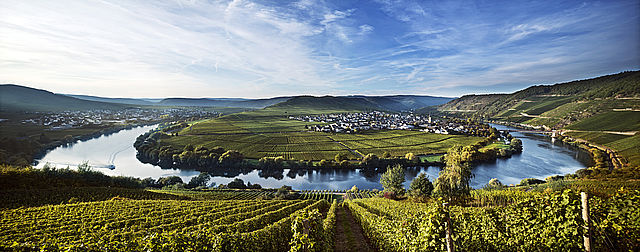Photo credit: Deutsches Weininstitut
Cool climate has become a bit of a buzzword for wine enthusiasts in recent years. Marginal climates on the very brink of where grapes can successfully ripen are increasingly being sought out by growers conscience of the long term potential they offer. As temperatures continue to rise, and drought conditions worsen in many hot growing areas, cooler climates offer an attractive solution to climate change. The current fashion in wine geek circles is for crisp, elegant, lighter wine styles that these sites yield.
Sadly, when wine lovers think cool climate wines, they too often overlook the original cool climate king…
Germany.
Germany’s original vineyards are said to have been planted some 2000 years ago by the Romans. Much like in Burgundy, the powerful monasteries of the Middle Ages are credited with identifying many of Germany’s finest terroirs. In the 18th and 19th centuries, German wines were as highly prized as their counterparts in France. Queen Victoria was well-known for her love of Rheingau wines from the Hochheim area. In many of his excellent books, wine writer Hugh Johnson sings the praises of the thrilling Rieslings of the Mosel and the Rheingau.
So why are German wines so hard to find on liquor store shelves and restaurant wine lists these days?
Yes, there were some dark days for German wine in the difficult aftermath of the the second world war. Firstly, a grape called Müller-Thurgau was widely planted through-out Germany. This variety was created by crossing two separate grapes (one being Riesling) in order to obtain a new, early ripening, high yielding grape that thrived in a wide range of soils and climates. The downside was that Müller-Thurgau produced a fairly bland, neutral white. The second issue was the rise in popularity, first domestically, and then internationally for a very sweet, insipid style of white wine called Liebfraumilch (think Black Tower, Blue Nun, Deinhard).
As these inferior wines proliferated, so to did mass consumer perception that this was the extent of Germany’s wine-making abilities. And stereotypes, once firmly established, die hard. Germany’s quality-minded wine producers never ceased producing excellent wines, and wine connoisseurs never ceased drinking them; these wines just became specialty products for those “in the know”.
As the trend toward drier white wine picked up steam in the 1980s and 1990s, Liebfraumilch sales waned and German wine began to disappear from larger liquor store shelves. Meanwhile in Germany, a quality revolution was quietly underway. Wine producers increasingly turned back to Riesling, began experimenting with sweetness levels, and singling out their best terroirs in single vineyard bottlings.
Today, the quality coming out of Germany is second-to-none, but the average wine drinker wouldn’t know that…because they can’t find any.
What is that makes German wines worth seeking out? Here are just a handful of reasons:
The Noble Riesling Grape
Riesling is praised by wine experts the world over, for its exceptional cellaring capacity and ability to express terroir. In simpler terms, the Riesling grape is very high in natural fruity acid. Acids act as a sort of preservative, allowing wines to maintain the vibrancy of their aromas and flavours over time. Riesling is rarely subjected to wine-making techniques (like malolactic fermentation or new oak ageing) that alter wine’s flavour profile. They tend to be light in body and delicate in texture. German Rieslings are often highly fragrant with aromas that range from apple, lemon, white flowers, and wet stone (in drier wines from the coolest areas) to intense honeyed, peachy, spiced notes for later harvested and/or warmer climate wines.
There is almost five times more Riesling planted in Germany than in any other country world-wide.
Riesling’s Wide Range of Styles
The Riesling grape excels in all styles, from sparking, to still; from bone-dry to lusciously sweet. Riesling’s high acid lends itself well to the production of quality sparkling wine. Its thin skins make it susceptible to botrytis (aka noble rot), a fungus that shrivels the grape berries intensifying sweetness and imparting interesting flavour compounds. The sweet German dessert wines made from partially to fully botrytised grapes are among the most complex, sought after wines in the world.
Quick guide to understanding sweetness levels on German wine labels:
- Dry Riesling: look for the term “Trocken” on the label, “Halbtrocken” or “Feinherb” wines will be marginally sweeter
- Sweet Riesling (in ascending order): Kabinett* (off-dry), Spätlese* (late harvested, medium sweet), Auslese (partially botrytised, sweet), Beerenauslese (heavily botrytised, very sweet), Trockenbeerenauslese or TBA (wholly botrytised, lusciously sweet), Eiswein (ice wine, no botrytis, sweet to lusciously sweet)
* Just for to make things more confusing, Kabinett and Spätlese wines can also be fermented dry (rather than have the fermentation halted while residual sugar remains in the wine, as is the case with good quality sweet wines). You will see the word Trocken on these labels.
Cool Climate Vineyards
Germany is the northernmost major wine-producing country in Europe. Its climate is cool and continental for the most part. Grapes grown in cool climates accumulate sugars more slowly. They require a longer growing season to fully ripen. Germany’s vineyards lack the abundant sunshine of more southerly origins, but they are blessed with warm, dry fall weather allowing the grapes to hang long on the vines. Grapes that ripen slowly like this tend to be fresher, with brighter fruit, and more complex (often mineral-laced) aromatics.
Steep Slopes & Winding Rivers
The favourable fall weather alone isn’t sufficient to ripen grapes in the coolest German vineyards. In places like the Mosel Valley, Riesling thrives due to the perilously steep slopes upon which it is grown. These sharp inclines give more direct sunlight to the vines therefore increasing the rate of photosynthesis. Rivers also play a major role in tempering chilly German weather. Water maintains stable temperatures far long than air. In cool climates, rivers act as heat reservoirs. All of Germany’s major vineyard areas grow along the banks of the Mosel (and its tributaries the Saar and Ruwer), the Rhine, and the Main rivers.
The Pinot Persuasion
Although Riesling is the best known German wine grape, many other varieties flourish here. In fact, Germany is the third largest producer of Pinot Noir in the world. Called Spätburgunder (sh-pate-boorgunder) here, the style varies widely from region to region but often features a pale garnet colour, crisp acidity, tart red fruit flavours, light to medium body, and smooth tannins. These vibrant reds offer fantastic value for lovers of earthier, fresher Pinot Noir styles. For tangy, silky versions look to the Ahr, Franken, or Rheingau. For bolder, fruitier styles, try Baden or Pfalz.
White Pinot grapes, namely Pinot Gris (aka Grauburgunder) and Pinot Blanc (aka Weissburgunder), are widely grown in the Rheinhessen, Baden, and Pfalz. Both grapes can be quite neutral and lean. However, when not over-cropped, and when vinified with care, they are both lovely, textural wines. Pinot Blanc tends to have firmer acidity, while Pinot Gris is more fragrant. Great German Pinot Gris is powerful and concentrated, with notes of ripe pear, tropical fruit, and spice. Pinot Blanc can be quite nutty and citrussy, with lovely freshness.
Perfect Balance
The single most important attribute a wine must have to pass muster with me, is balance. All elements that one can smell and taste must seem harmonious to the nose and palate. On a balanced wine, the aromas, the flavours, the acidity, the alcohol, the tannins and so forth all work together like an orchestra to create one beautiful sound from many different instruments. Whereas, on an unbalanced wine, certain aspects will seem jarring, and out of synch.
I regularly taste high acid wines with little to no sweetness, and find them so lean and austere that they provide little drinking pleasure. Where acidity is high, as with Riesling, residual sugar can provide an attractive counter-weight, enhancing the fruity flavours. Before dismissing the sweeter Riesling wine styles, try them against bone-dry Rieslings and see for yourself. I am constantly met with wine lovers who swear they only drink dry wines, only to prefer a slightly sweeter style when given a selection to taste. Also, high acidity levels mask the perception of sweetness. You may think your favourite wine is bone-dry, only to find it is slightly sweet. Next time you drink a bottle of Champagne, check the sugar level.
Other Benefits
Cool climate wines struggle to ripen and therefore never attain very high alcohol levels. In the case of sweeter wines, the arrested fermentation process means that not all the sugar has been transformed into alcohol resulting in even lower alcohol levels. German Riesling ranges from 5.5% alcohol for the very sweet wines, up to 12% for the driest examples. Even the red wines rarely exceed 13%.
For me, German Riesling is the perfect hot summer’s lunch wine. Its vivacious acidity quenches your thirst, and its low alcohol won’t leave you yawning.
Avoiding the Pitfalls
Before you race to the store to buy the first German wine you see, there are some basic rules to follow. Unfortunately, syrupy sweet, characterless German wine still exists today. Avoid the cheapest options (in this market that pretty much means everything under 15$). And if you really and truly don’t like sweetness in your white wine, scan the label for the word trocken.
If you are keen to try German sparkling wine (called Sekt), look out for a mention of origin on the bottle. Cheap German Sekt is truly dreadful stuff, with a heavy, candied sweetness. The grapes can be sourced from anywhere in the EU, so do not reflect German vineyard fruit.
For dry to sweet wines, if you prefer a very light, delicate style with elegant, tangy fruit, mineral and floral notes look for wines from the Mosel Valley or Nahe. If you want something a shade more powerful, steelier in structure, but equally racy, Rheingau is for you. Finally, if you want more rounded acidity, riper fruit and spicy notes, the Pfalz region offers this an abundance.
A Couple of Suggestions
In a recent tasting of over 100 German wines here in Montréal, only a handful were available for purchase at the SAQ. Here are my top 4 to get you started on your German wine journey:
Selbach-Oster Riesling QbA 2016 – 89pts VW
Incredibly lively white with moderate intensity of red apple, honey and ripe lemon aromas. Piercing acidity offsets the subtle sweetness nicely on this delicate, light-bodied white. The finish is clean, and fairly brimming over with juicy, tangy fruit.
Where to buy: SAQ (18.20$)
Weingut Leitz Eins Zwei Dry 2016 – 88pts VW
Crafted in a “dry” style, the 9g/L residual sugar is barely perceptible here. This is a classically styled Rheingau with its bracing acidity, firm structure, and hints of peach, lemon, and stony minerals. This zesty white is a sure to get your taste buds jumping.
Where to buy: SAQ (19.25$).
Villa Welter Weissburgunder Trocken 2016 – 87pts. VW
Restrained, yet elegant on the nose with subtle pear, green apple and floral notes. This charming, biodynamic Pinot Blanc really comes alive on the palate. Crisp, yet rounded acidity, an attractive layered texture and lingering saline hints on the finish.
Where to buy: SAQ (20.00$)
Reichsgraf Von Kesselstatt Piesport Goldtropfchen Grosses Gewachs Riesling 2014 – 93pts. PW
Lovely complexity on the nose. Slatey minerality is underscored by delicate floral notes, yellow apples and hints of petrol. Notes of raw honey and peach develop with aeration. The palate is silky and light, yet impressively concentrated, with racy acidity ably matched by incredibly vibrant fruit. The finish is long and mineral-laden.
Where to buy: SAQ (45.00$)
For those keen to explore further, here is a short list of other excellent German wine producers currently sold in limited volumes through the SAQ:
Joh. Jos. Prüm, Mosel Valley
Willi Schaefer, Mosel Valley
Weingut Weiser-Künstler, Mosel Valley
Weingut Hermann Dönnhoff, Nahe
Weingut Klaus Keller, Rheinhessen
Weingut Künstler, Rheingau
Weingut Ökonomierat Rebholz, Pfalz





No Comments